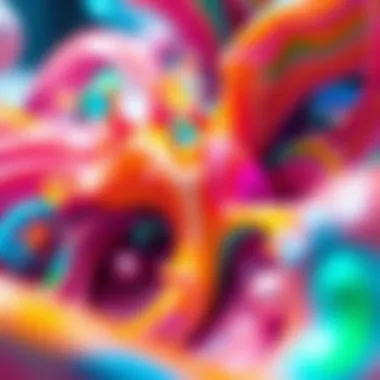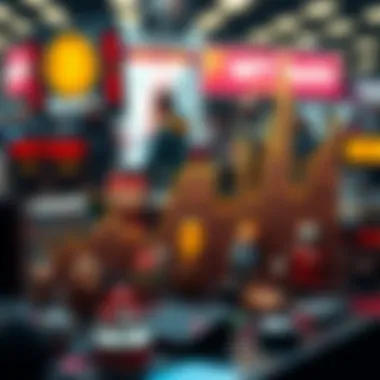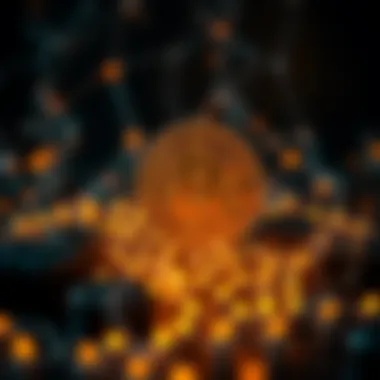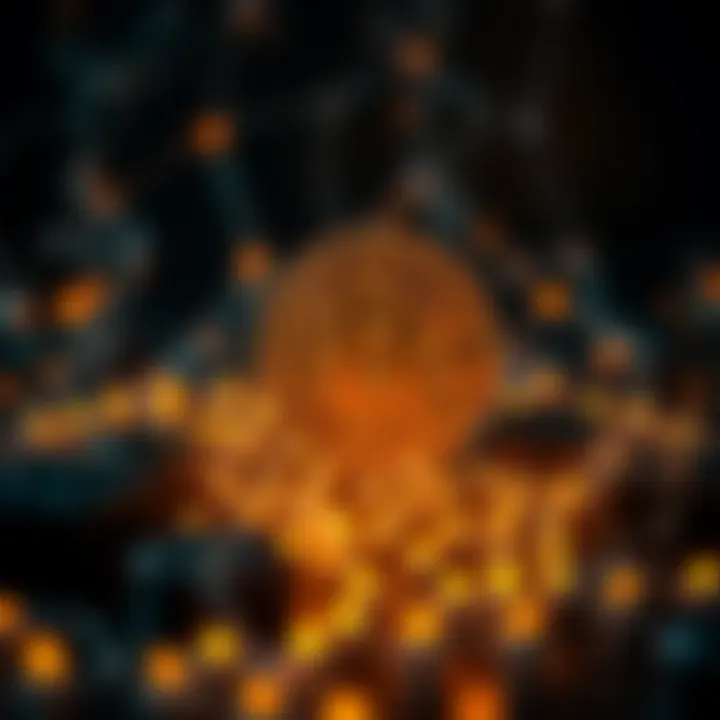The Landscape of Expensive NFT Art: Insights and Implications


Intro
In recent years, a digital revolution has unfolded, reshaping the art world through the rise of Non-Fungible Tokens (NFTs). While traditional art has long been prized for its tangible qualities, the emergence of NFT art is generating buzz among investors and collectors alike. But what makes this new form of art so compelling? In this discussion, we’ll delve into the intricacies of the NFT art market, the factors influencing its pricing, and the innovations grounding this digital phenomenon.
The landscape of NFT art is not only about virtual ownership. It encapsulates broader implications for artists, collectors, and the economy, raising questions about authenticity, environmental consequences, and the very nature of creativity itself. As we explore the market trends and technological advancements, we aim to offer a clear lens for those navigating this complex terrain.
Market Trends and Analysis
Current Market Overview
NFT art has skyrocketed in popularity, especially in the past couple of years. Initially characterized by a few high-profile sales that grabbed headlines, the market has seen exponential growth, not just in sales prices but in the number of active participants. Artists and collectors from various backgrounds have rushed into this space, seeking novel ways to express and experience art.
One might say the market's evolution is akin to the gold rush of the 19th century. Prices for landmark pieces like Beeple's "Everydays: The First 5000 Days" at Christie's sold for a staggering $69 million. Other pieces, though less flashy, command significant sums that signal a change in how art is valued. With artists exploring innovative styles and mediums, it seems the bar for price thresholds keeps getting raised.
Key Influencers Affecting Prices
Several factors come into play when determining NFT prices:
- Scarcity: Just like traditional art, rarity drives demand. Limited edition pieces can entice buyers due to their exclusiveness.
- Artist Reputation: Familiarity with an artist often translates into higher prices, as established names can leverage their legacy for more value.
- Market Speculation: Prices can fluctuate wildly based on speculation, reminiscent of stock markets. A buzz can inflate values overnight.
Understanding these influences can give investors better insight into potential purchases, minimizing risks associated with sudden market swings.
Technology and Innovation
Breakthroughs in Blockchain Technology
The backbone of NFT art is blockchain technology, which enables the secure and transparent verification of digital ownership. Unlike traditional certificates of authenticity, blockchain offers an immutable record. This ensures that provenance can be traced back to the original creator, which is a game-changer for artists concerned about copyright infringement and forgery.
Popular platforms like Ethereum play a pivotal role in facilitating these transactions, allowing artists to mint their creations as NFTs. The landscape continues to evolve, with newer blockchains emerging that aim to improve scalability and reduce energy consumption.
The Role of Smart Contracts
Smart contracts are another innovation making waves in the NFT world. These self-executing contracts automatically facilitate terms agreed upon by buyers and sellers, reducing the need for intermediaries. For instance, an artist can embed royalties in their NFT, ensuring they receive a continuous income every time their work is resold.
By marrying blockchain technology with smart contracts, the industry empowers artists to retain control over their work while providing a streamlined process for transactions.
In essence, NFTs are not merely digital assets; they are a redefinition of ownership in the art world.
As the NFT art market expands, so do the implications of this technological marriage. Investors and developers must keep abreast of advancements, understanding how shifts in technology can transform market dynamics and valuation methodologies.
Prelude to NFT Art
The emergence of Non-Fungible Tokens (NFTs) has ignited a burgeoning conversation around digital artistry. As artists, collectors, and investors flock to this dynamic market, the significance of understanding NFT art cannot be overstated. This section is crucial as it lays the groundwork for dissecting not just the art itself but the very concept of ownership in the digital realm. People are increasingly becoming enchanted by the idea of owning a unique digital asset, and NFTs provide that allure, transforming pieces of art that existed only in pixels into prized possessions.
NFT art serves as a bridge connecting traditional artistry with the unbounded potentials of technology. This intersection introduces new intricacies concerning valuation, provenance, and marketplace behavior. With many turning their backs on traditional platforms, it becomes essential to delve deep into the mechanisms that propel this sector forward. Thus, the landscape of NFT art is not just a fleeting trend; it reflects profound shifts in how we perceive value and creativity.
In unpacking this topic, we can explore various facets including the mechanisms behind NFTs, their historical rise, and the implications for artists and investors alike. This foundational understanding is essential for engaging with the upcoming sections, where we will probe into the valuation of expensive NFT art and the broader market dynamics that shape this field.
Understanding Non-Fungible Tokens
In the marketplace of crypto-assets, NFTs stand out as a novel category. Unlike cryptocurrencies such as Bitcoin or Ethereum, which can be exchanged on a one-to-one basis, NFTs are inherently unique. Each token is tied to a specific digital file, giving it individuality and thus, a degree of value. This uniqueness is what attracts creators to the NFT space, as it allows them to tokenize their work, providing authenticity and ownership to buyers.
The concept of non-fungibility relates closely to the world of collectibles. If you think about trading cards, each one has its distinct value, whether it's a rare holographic card or a common one; similarly, each NFT possesses its own worth depending on factors like the artist's reputation, the rarity of the piece, and market demand. The transparency of blockchain technology ensures that all transactions are recorded, granting comprehensive verification of each NFT's origin, ownership history, and transfer.
More than just digital badges of ownership, NFTs carve out possibilities for ongoing royalties, allowing artists to earn a percentage every time their work gets resold. This shift in the paradigm of art ownership is catalyzing new conversations about creator rights and engagements in an increasingly digital world.
Historical Context of Digital Art
Before NFTs burst onto the scene, digital art had already begun to carve out its niche within the broader artistic landscape. The advent of personal computing and the internet sparked an explosion of creative potential, allowing artists new tools for expression. However, this democratization of art came with challenges—chief among them was the question of ownership. Digital works could be easily replicated, leading to concerns over copyright and authenticity.
As technology evolved, the early 2000s saw the rise of platforms such as DeviantArt and Behance, where artists could share their digital creations widely. Yet, without a robust system for ownership, many creators struggled financially, often relegated to the shadows of their more conventional peers. The introduction of NFTs in 2017 marked a significant turning point, offering solutions to these long-standing issues.
Through pioneering projects like CryptoPunks and NBA Top Shot, the notion of digital art transformed overnight. Instead of existing as an ephemeral experience, art became something tangible and tradable. Artists who had once been confined by the limitations of their mediums now found themselves at the forefront of a new frontier, gaining recognition and substantial financial rewards for their digital crafts.
In summary, understanding the context in which NFT art emerged is paramount. The evolution from simple digital files to coveted assets encapsulates a broader transformation in both artistic creation and consumption, offering an intriguing prelude to the exploration of high-value NFTs that will follow.
"Art is not what you see, but what you make others see." - Edgar Degas


For more on the implications of digital art, consult resources like Wikipedia on NFTs or Britannica's history of digital art.
Exploring these nuances prepares readers to appreciate the complex dynamics of valuation and market forces at play in the realm of expensive NFT art.
Valuation of Expensive NFT Art
Understanding the valuation of expensive NFT art is crucial for anyone who wishes to engage seriously in this evolving digital marketplace. The monetary worth of these digital pieces is not simply a number; it signifies a convergence of tech, creativity, and speculative investment. As much as the elegant visuals of these tokens catch the eye, their market price intertwines intricate factors with a dash of emotion and aspiration. Investors, art enthusiasts, and analysts all have stakes in untangling this pricing enigma, as it holds profound implications for the future of digital art.
When considering valuation, several layers unfold. The first element hinges on scarcity—each NFT is unique or part of a limited series, creating a sense of exclusivity. This scarcity can send prices soaring, akin to rare stamps or coins. However, scarcity alone doesn’t paint the full picture. Things like artist reputation, historical significance, and community engagement can sway the market significantly. NFTs created by artists who are already well-known can fetch higher prices compared to those from emerging creators. It’s a blend of established credibility and the promise of future value that captures the investor's attention.
Another consideration is the time factor. The greater the significance of an NFT at its time of sale, the more demand it likely will attract. Trends can shift, and so can tastes, making it imperative to understand the current market sentiment. The valuation of NFT art is fluid, influenced by social media buzz and broader economic trends in the crypto space.
Potential benefits of a solid understanding of valuation yield fruitful rewards. Investors can make more informed decisions, find opportunities for growth, and avoid pitfalls of overinflated pricing. Additionally, this knowledge can lead to a deeper appreciation of the artistic elements involved in the digital landscape. In short, being savvy about valuation doesn't just pad one’s wallet; it enriches the entire experience of engaging with NFT art.
Factors Influencing Price
The price tag attached to an NFT can be swayed by numerous elements, making it a bit of a puzzle for new investors and seasoned collectors alike. Here are a few factors that play a pivotal role:
- Artist's Backstory and Reputation: Just like in traditional art, the artist's previous works, reputation, and even their social media presence can make or break the price of an NFT. A piece by a well-known artist often commands a higher price.
- Quality and Uniqueness of the Art: The aesthetic value cannot be downplayed. Unique, visually striking art tends to attract more buyers.
- Market Trends: Sometimes, trends can feel like shifting sands—what's in one moment might be out the next. Keeping tabs on current trends in both art and technology often provides crucial insight.
- Historical Sales Performance: Analyzing historical data can give perspective on how previous sales of similar NFTs performed, thus influencing potential buyers on current listings.
Comparison with Traditional Art Markets
Comparing the NFT market with traditional art markets reveals striking contrasts and intriguing parallels. Though both realms revolve around artistry and expression, their underlying dynamics diverge significantly.
For one, the transaction process of NFTs operates on a real-time basis. A collector might sell an NFT in mere hours, unlocking liquidity which traditional art often lacks. Selling a physical painting can take months or even years, typically involving galleries and exhibitions. Conversely, NFT sales rely heavily on platforms like OpenSea or Rarible, where transactions can happen at the click of a button.
Moreover, the audience plays a role. Traditional art aficionados are often entrenched in historical contexts, whereas crypto-art enthusiasts are often driven by novelty and the allure of technology. Those in the NFT space might make purchasing decisions based on community involvement or digital status indicators, such as ownership of previous highly-valued tokens.
Lastly, regulatory scrutiny also hits differently. Traditional art markets have established legal frameworks governing transactions and authenticity. NFTs are just beginning to undergo the scrutiny of regulations, leading to uncertainty regarding the future landscape. However, this also creates a unique window of opportunity for innovation.
In sum, understanding how the valuation of NFTs stacks against traditional art markets not only enhances comprehension of the digital landscape; it also illuminates paths forward for collectors and investors navigating this often-turbulent territory.
Prominent Examples of High-Value NFTs
The realm of expensive NFT art has seen noteworthy exemplars that capture both monetary value and cultural significance. These high-value NFTs serve as touchstones in understanding the broader implications of digital ownership and investment. They are essential not only for artists and collectors but also for those seeking to comprehend how digital assets fit into contemporary art narratives.
These standout pieces often attract attention due to the sheer magnitude of their sales and the stories behind them. They provide insights into what drives valuation in a space that blends creativity with economic speculation. Additionally, examining these examples sheds light on the multifaceted relationships between artists, buyers, and the digital platforms that host their work.
Notable Sales and Their Impact
Several sales in the NFT space have made headlines, drawing interest not just for their price tags but also for their implications on art valuation. One such instance is the sale of Everydays: The First 5000 Days by Beeple, which fetched a staggering $69 million at a Christie’s auction. This sale was a significant marker in recognizing digital art as a legitimate collector's item alongside traditional forms.
- The transaction did more than just highlight a personal milestone for the artist; it shattered preconceived notions about the value of art in digital formats.
- Following this sale, numerous discussions sprouted around the sustainability of such pricing and what it means for both artists and investors. Some critics argue that it could create a speculative bubble, while advocates emphasize the potential for democratizing art ownership.
Another fascinating case is that of the CryptoPunks series, where a single digital punk sold for over $11 million. The cultural impact of CryptoPunks is immense; they not only signify the creation of digital collectibles but also question the nature of ownership — transforming how individuals perceive their relationship with art.
"The sale of high-value NFTs has stirred debates, influencing both market dynamics and cultural attitudes toward digital ownership."
Artists Behind Expensive NFTs
Delving into artists who create high-value NFTs reveals the diversity and innovation present in this space. Names like Beeple have become synonymous with the NFT boom, but the landscape is filled with emerging talents. Artists such as Pak and Grimes have also garnered substantial acclaim and sales, showcasing a variety of styles and concepts within the medium.
- The artists behind these high-ticket items often employ unique narratives or techniques that resonate with an increasingly tech-savvy audience. This is not merely a transaction of art; it reflects broader cultural conversations around identity and the future of creativity.
- Additionally, some artists use sales from NFTs to fund social and altruistic projects, enhancing their work's significance beyond just monetary aspects. This injects a layer of purpose into the digital art scene, demonstrating that creativity and social responsibility can coexist.
To summarize, notable sales and innovative artists together weave a complex narrative within the expensive NFT art landscape. They highlight challenges and considerations for investors while emphasizing the evolving nature of art in the digital age. Understanding these examples allows stakeholders to navigate the intricacies of market trends, technological frameworks, and the cultural significance of NFTs.
Market Dynamics of NFT Art
Understanding the market dynamics of NFT art is crucial for anyone looking to navigate this complex but increasingly valuable sector. Market dynamics delve into the buying and selling behaviors, which directly impact pricing, sentiment, and overall investment potential. This section seeks to outline the fundamental factors influencing these dynamics, shaping the current landscape of NFT art.
Trends in Buying and Selling
The trends in buying and selling NFT art reveal a lot about the changing tastes of collectors and investors. The surge in popularity of NFTs coincided with the global pandemic, where more people sought solace and escape in digital realms. Crafting a narrative around the purchasing behavior lends insight into how these tokens have found footing in modern culture.
The notion that collectors are now willing to splurge on digital artworks is reshaping the narrative of art ownership. Unlike traditional artworks, which require physical storage and display, NFTs offer a unique blend of ownership with the convenience of being enjoyed anywhere digitally.
Additionally, some trends to consider include:


- Youth Engagement: A significant driver for NFT sales is the younger demographic who embrace digital art as a medium. They often see NFTs as a new canvas for expression, unchained from the conventional art world.
- Social Media Influence: Platforms like Twitter, Instagram, and Discord have become virtual marketplaces for NFTs. Artists showcase their works, and buyers often engage with them directly—this breaks the traditional art gallery model.
- Viral Content: Specific artworks garner overwhelming attention, sometimes through influencers or significant events, causing sudden spikes in demand and price. This trend reflects a social proof aspect where value is placed on what is trending.
The Role of Auction Platforms
Auction platforms play an instrumental part in the marketplace for NFT art by providing a venue where buyers can bid on digital pieces created by artists worldwide. These platforms serve not merely as intermediaries but as facilitators of a new economic model surrounding digital art investments.
- Leading Platforms: Sites like OpenSea, Rarible, and SuperRare have made headlines with high-profile auctions. OpenSea, being one of the largest, provides an extensive range of NFTs—from art to music, offering diverse investment opportunities.
- Auction Dynamics: Auctions create a sense of urgency among buyers. The competitive nature of bidding can inflate prices beyond expected values, making the auction process a double-edged sword in terms of market value stability.
- Curation and Discovery: Many platforms emphasize the importance of curation. By spotlighting specific artists or themes, they guide buyers toward trending or emerging pieces, influencing market dynamics further. This balance of discovery and exclusivity can have a significant impact on an artist's visibility and perceived value.
Moreover, auction platforms support ecosystem functionality by utilizing blockchain technology, ensuring provenance and authenticity. This has created a trust factor that is essential in the art world, particularly concerning digital ownership.
“The role of auction platforms cannot be overstated; they form the backbone of the NFT art economy, bridging the gap between artists and collectors while paving the way for stability and growth.”
In summary, by understanding how these platforms operate and influence the market, investors can position themselves effectively within the evolving landscape of NFT art. Staying updated about these dynamics is essential to make informed decisions in a fast-paced and sometimes volatile marketplace.
Technological Frameworks of NFTs
When discussing the world of NFTs, it’s crucial to grasp the underlying technology that makes them possible. The technological frameworks of NFTs serve as the backbone of this digital revolution in art. This portion of the article will illuminate the significance of blockchain technology and smart contracts, both of which play integral roles in the creation, sale, and ownership of NFTs.
Blockchain Technology Explained
The essence of NFTs lies in blockchain technology. Essentially, a blockchain is a decentralized digital ledger that securely records transactions across numerous computers. This technology ensures transparency and security, two elements that are paramount in the digital art landscape.
Each NFT exists on its own unique blockchain, typically Ethereum, though others like Tezos and Flow are emerging as viable alternatives. The decentralized nature of these blockchains means that no single entity has control over the data. This decentralization not only fosters trust among buyers and collectors but also protects against tampering.
Moreover, the use of blockchain allows artists to embed metadata within their creations. This metadata can include everything from the artist’s name to the transaction history, enhancing the artwork's provenance. Provenance, in this context, refers to the history of ownership which carries significant weight in determining value in the art world.
Key benefits of blockchain technology in relation to NFTs include:
- Security: Transactions are cryptographically secured, reducing the risk of fraud.
- Transparency: All transactions are publicly verifiable, allowing for easier tracking of ownership.
- Ownership Rights: Artists retain rights to their works via smart contracts, enabling them to earn royalties from secondary sales.
Smart Contracts and Their Importance
Smart contracts are self-executing contracts with the terms of the agreement directly written into lines of code. In the context of NFTs, smart contracts automate the processes of buying, selling, and transferring ownership. These contracts don’t require intermediaries, which reduces transaction costs and speeds up the process significantly.
For instance, an artist can create a smart contract that stipulates a percentage of future sales are directed back to them. This shift in control gives artists a new level of financial sustainability, transforming how they engage with their audience and collectors.
Inclining back to the example of provenance, smart contracts play a pivotal role in maintaining the integrity of an NFT. When an NFT is sold, its smart contract updates its ownership and transaction history automatically, ensuring that the information remains accurate and tamper-proof.
The importance of smart contracts includes:
- Automation: They facilitate streamlined transactions without manual intervention.
- Transparency: Embedded terms in smart contracts are accessible to all parties involved.
- Loyalty: Artists can set terms guaranteeing compensation for every sale beyond the initial one.
In summary, understanding the technological frameworks of NFTs—namely blockchain technology and smart contracts—is essential for anyone engaging in this market. These components not only enhance the security and integrity of NFT art but also empower creators in unprecedented ways, shaping the future of digital art as we know it.
"A blockchain solution is only as strong as the smart contract that powers it."
For further exploration of these technologies, consider visiting resources like Wikipedia on Blockchain, The Britannica for in-depth analysis, and professional forums like Reddit on NFTs for community discussions.
Environmental Concerns Related to NFTs
The rise of non-fungible tokens has sparked a thrilling evolution in the art world, but it hasn't come without its share of criticisms. One of the most pressing discussions centers around the environmental impact of NFTs, particularly due to the energy-intensive nature of blockchain technology. This section aims to shed light on these concerns, addressing both the carbon footprint linked with blockchain transactions and exploring sustainable alternatives in the NFT space.
Carbon Footprint of Blockchain Transactions
Blockchain networks, especially those relying on proof-of-work models like Bitcoin and, in some instances, Ethereum, consume staggering amounts of electricity. Estimates suggest that the energy used for NFT transactions could rival that of an entire country. Such comparisons evoke a sense of urgency, given that the planet is already grappling with climate change.
The crux of the issue relates to how transactions are verified and recorded on these decentralized networks. Miners—individuals or entities who validate transactions—must solve complex mathematical problems, which require substantial computing power and energy. This process, while ensuring security and transparency, contributes to high greenhouse gas emissions. A single NFT sale could leave a carbon footprint comparable to that of a round-trip flight from New York to London.
"The ecological toll of NFTs is a clarion call for change within the digital art ecosystem."
Some innovators in the NFT space have begun pondering: is there a way to keep the creative spirit alive while also being kind to the planet? The discussion is crucial, not only for artists but also for collectors and investors who increasingly want to factor sustainability into their purchasing decisions.
Sustainable Alternatives in the Space
As awareness around the environmental ramifications grows, several blockchain platforms are pivoting toward sustainable practices. More eco-conscious options are sprouting, aiming to reduce energy consumption and emissions significantly. Here are notable examples:
- Proof-of-Stake Blockchains: Unlike proof-of-work systems, proof-of-stake operates on a model that requires less energy. Blockchains like Tezos and Flow utilize this technique, allowing NFTs to be minted with a considerably lower carbon output.
- Carbon Offsetting Initiatives: Some platforms are beginning to pair NFT sales with climate-positive initiatives. This means that part of the revenues from NFT sales will go toward planting trees or investing in renewable energy projects.
- Alternative Transaction Methods: Innovations in transaction methods that take advantage of less energy-intensive technologies are also in development. Initiatives like off-chain transactions may allow users to bypass the energy drawbacks of layer-one blockchains.


By understanding these dimensions, stakeholders can make informed decisions that echo their values, proving that digital artistry can be both innovative and environmentally responsible.
Cultural Significance of Digital Art
The rise of digital art, especially in the form of NFTs, has raised important questions about how we perceive and value art in our contemporary society. Cultural significance is often tied to changes in societal structures and prevailing philosophies, and digital art is no exception. As more artists turn to digital mediums and NFTs to showcase their work, we see shifts that challenge traditional aesthetics, practices, and even the very definition of art itself.
One of the most striking aspects of this shift is how digital art democratizes creativity. Artists from various backgrounds can upload their work to platforms that allow instant global reach. Unlike traditional galleries, where access might be restricted by geography or financial barriers, digital art presents an opportunity for anyone with an internet connection to enter the art realm. This is an essential turning point in a field that has historically been exclusive.
Digital art also facilitates new forms of expression. Artists blend technology and creativity to produce work that is interactive, immersive, and often multisensory. This evolution not only attracts a newer audience but also invites those within the art community to reconsider what "art" can be. Moreover, emphasizing collaboration, many digital artists thrive on collective input, generating pieces that grow from shared experiences rather than solitary endeavors.
Key benefits of the cultural significance of NFTs can be summarized as follows:
- Accessibility: Broader access for artists and audiences removes the elitism prevalent in conventional art markets.
- Innovation: Encouragement of experimentation leads to fresh artistic narratives and dialogues.
- Connectivity: Increased interaction between artists and collectors fosters stronger community ties.
In navigating this new landscape, it’s important to tread carefully and thoughtfully. As NFT markets burgeon, concerns regarding intellectual property and ownership also rise. The intrinsic value of art has never been solely about financial returns, and the cultural implications of these shifts should be carefully weighed.
Shift in Artistic Perception
The advent of digital art, particularly with NFTs, is significant in how we perceive art. Traditionally, art had a tactile quality; one could touch a canvas, feel the brushstrokes, even smell the paint. Digital art, however, confronts such notions head-on. On one hand, some purists may view NFTs as mere gimmicks, lacking the "soul" found in traditional art. Yet, this perspective can be limiting. Digital spaces can extend narratives beyond static pieces, making them dynamic and mutable.
Moreover, the perception of ownership has transformed. When someone purchases an NFT, they are not acquiring physical possession but instead receiving a unique digital token that certifies authenticity. This shift provokes a broader philosophical dialogue regarding what it means to own a piece of art. One doesn’t have to hang a digital piece on the wall to appreciate it; its presentation can transcend physical boundaries, reaching users through screens globally.
"The beauty of digital art lies in its ability to untether creativity from physical limitations, allowing it to thrive in an ever-evolving ecosystem of expression."
Impact on Traditional Artistic Practices
The rise of NFTs and digital art influences traditional artists in various ways. Many are now integrating digital techniques into their work, blending mediums to create hybrid practices. For instance, a painter might experiment with augmented reality, using technology to enhance the viewer's experience of their canvas. This convergence of traditional and digital practices can result in fresh artistic movements, appealing to both seasoned art lovers and newcomers alike.
Furthermore, the anxiety around financial viability has pushed traditional artists to explore digital avenues. The prospect of selling art as NFTs offers an additional revenue stream, thus encouraging more artists to experiment with digital forms. Many artists who once relied solely on galleries are now turning to platforms like OpenSea or Rarible, adapting to current market demands.
However, this adaptation is not without its challenges. The tactics necessary to navigate the digital landscape require artists to develop new skills. Familiarity with technology, understanding blockchain nuances, and engaging with online communities are all essential components that artists must embrace. This evolution necessitates an openness to continuous learning, as the digital art scene is as dynamic as it is multifaceted.
The intersection of traditional practices and digital innovation signifies not just a change in art form but a cultural transition that has far-reaching implications. As the art world evolves, understanding this cultural significance will be paramount to engaging with its future.
Future of Expensive NFT Art
The future of expensive NFT art is a topic that resonates deeply across various sectors, including finance, technology, and creative industries. As digital assets continue to carve out their niche, understanding the implications of this trend is pivotal for investors, artists, and technologists alike. The market for NFT art is evolving, presenting both opportunities and challenges that demand careful consideration.
Predicted Market Trends
Looking ahead, the NFT art market is anticipated to witness several key trends shaping its landscape:
- Increased Market Maturity: As more traditional artists and collectors venture into the NFT space, one can expect a formalization of the market processes. This includes clearer provenance, enhanced artist royalties, and improved platforms for distribution.
- Diversity in Art Forms: The types of art being tokenized are likely to expand significantly. Beyond digital paintings, expect to see incorporated forms like music, virtual reality experiences, and mixed media works gaining traction.
- Community-Driven Initiatives: Decentralized platforms may emerge that focus on community involvement and decision-making. Artists and collectors might collaborate more, creating collective pools of NFT art, which can democratize access and foster unique project developments.
- Integration with Physical Art: As artists blend physical and digital forms, the distinction between traditional and NFT art may blur, allowing for new buying experiences. For instance, owning an NFT could offer exclusive rights to a physical piece.
- Economic Fluctuations: Just like any market, NFT art will likely react to the wider economic climate. Factors such as inflation or shifts in consumer spending habits could influence buying power and interest in high-value NFTs.
The adaptability and innovation within the NFT art market could define its sustainability in the long run.
The Role of Regulation
The growing interest in expensive NFT art has not gone unnoticed by regulators worldwide. Here are several elements related to how regulation could impact the future of this market:
- Consumer Protection: Clear guidelines could establish standards for authenticity and ownership, providing consumers with recourse in cases of fraud or misrepresentation.
- Tax Implications: As NFTs gain recognition, tax authorities may introduce new frameworks to manage capital gains or income derived from sales, affecting how both collectors and artists operate.
- Digital Rights Management: Regulatory bodies may pursue legislation that protects intellectual property associated with digital art. This will likely influence how NFTs are created, sold, and transferred.
- Environmental Regulations: With the environmental concerns surrounding blockchain technologies, regulations might promote greener practices within the industry, encouraging more sustainable platforms.
- Global Disparities: Regulations can differ greatly across borders, potentially leading to a fragmented marketplace. Understanding local laws becomes vital for anyone engaging in this space.
A well-regulated environment is essential to preserve the integrity and potential of the NFT art market while providing a safety net for participants.
Epilogue: Navigating the NFT Art Market
As the curtain falls on our exploration of the expensive NFT art market, it's essential to pause for a moment and consider the multifaceted implications of this fascinating landscape. The digital art world is not merely a fad; it has profound economic, cultural, and environmental ramifications. In this concluding segment, we shine a light on the key elements that define this ecosystem and address the aspects investors must consider when engaging with this new art form.
In summary, the NFT art market is drastically different from traditional avenues, largely because of its accessibility and the democratization of art ownership. The technology underpinning NFTs—particularly blockchain—affords artists an unprecedented level of control over their work while providing transparency for buyers. This shift holds significance, as it marks a fundamental change in the discourse around authenticity and value in the art realm.
Moreover, as investors and collectors navigate this digital frontier, they should remain cautious, balancing excitement with due diligence. While there are boundless opportunities, the risk involved cannot be overlooked. Timing the market, verifying authenticity, and understanding the volatility intrinsic to NFTs could make the difference between a well-timed investment and a financial misstep.
"In the world of NFTs, caution is just as vital as excitement; understanding the landscape prepares you for the journey."
Key Takeaways
- Market Evolution: The NFT art market continues to evolve rapidly, impacting how artists present their work and how collectors view value.
- Technology's Role: Blockchain technology and smart contracts are crucial in ensuring the authenticity and ownership of NFT art, which fortifies the collectors' investment.
- Investment Risks: The landscape is riddled with risks, including market volatility and potential regulatory changes, which necessitate careful planning and strategy.
- Environmental Impact: Increasing awareness regarding the carbon footprint of NFTs is spawning discussions about sustainable practices, underlining the need for responsible participation in this market.
Advice for Potential Investors
Investing in expensive NFT art may be alluring, but wise investors should adopt a methodical approach. Here’s a compilation of insights to steer your path:
- Research Extensively: Study the market trends, recent sales, and primary platforms where NFTs are bought and sold. Keeping an eye on marketplaces like OpenSea or Foundation can provide deep insights.
- Verify Authenticity: Always check the provenance of an NFT. Use reputable platforms and confirm the legitimacy of the artist and the artwork to avoid scams.
- Diversify Investments: As with any investment strategy, it's advisable to diversify. Consider investing not just in high-value pieces but also in emerging artists and mid-range works.
- Stay Updated: The NFT space evolves constantly—new technologies, trends, and regulations emerge daily. Subscribing to industry news can guide your decisions.
- Engage with the Community: Connect with other collectors and artists. Platforms like Twitter and Reddit, as well as Discord communities, foster valuable discussions and insights.
Navigating the NFT art market, as highlighted, requires a blend of caution, knowledge, and adaptability. As this digital frontier matures, those who are prepared can genuinely benefit from their investment endeavors.



